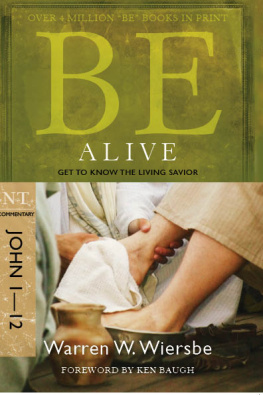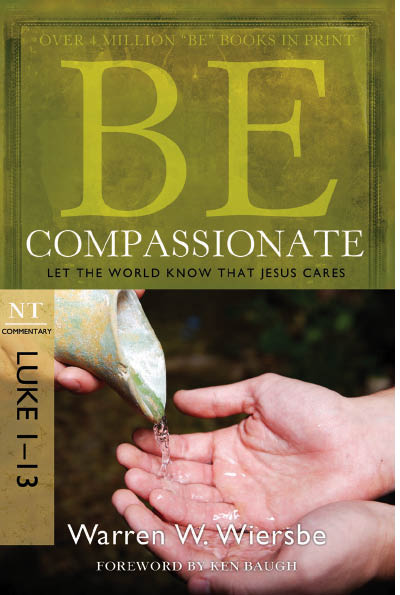BE COMPASSIONATE
Published by David C. Cook
4050 Lee Vance View
Colorado Springs, CO 80918 U.S.A.
David C. Cook Distribution Canada
55 Woodslee Avenue, Paris, Ontario, Canada N3L 3E5
David C. Cook U.K., Kingsway Communications
Eastbourne, East Sussex BN23 6NT, England
David C. Cook and the graphic circle C logo
are registered trademarks of Cook Communications Ministries.
All rights reserved. Except for brief excerpts for review purposes,
no part of this book may be reproduced or used in any form
without written permission from the publisher.
Unless otherwise noted, all Scripture quotations are taken from the King James Version of the Bible. (Public Domain.) Scripture quotations marked NASB are taken from the New American Standard Bible, Copyright 1960, 1995 by The Lockman Foundation. Used by permission; NIV are taken from the Holy Bible, New International Version. NIV . Copyright 1973, 1978, 1984 by International Bible Society. Used by permission of Zondervan. All rights reserved; NKJV are taken from the New King James Version. Copyright 1982 by Thomas Nelson, Inc. Used by permission. All rights reserved; ASV are taken from The American Standard Version. (Public Domain); and WUEST are taken from The New Testament: An Expanded Translation by Kenneth S. Wuest 1961 by the Wm. B. Eerdmans Publishing Co. Used by permission. The author has added italics to Scripture quotations for emphasis.
LCCN 2010923218
ISBN 978-1-4347-6502-4
eISBN 978-1-4347-0215-9
1988 Warren W. Wiersbe
First edition of Be Compassionate published by Victor Books in 1988 Warren W. Wiersbe, ISBN 978-0-89693-591-4
The Team: Karen Lee-Thorp, Amy Kiechlin, Sarah Schultz, Jack Campbell, and Karen Athen
Series Cover Design: John Hamilton Design
Cover Photo: iStockphoto
Second Edition 2010
To my friend and physician Dr. Dale E. Michaels, who shares with Dr. Luke a love for Jesus Christ, a compassionate heart, and a concern to reach the world with the gospel
CONTENTS
The Big Idea: An Introduction to Be Compassionate by Ken Baugh
A Word from the Author
1. Hear the Good News! (Luke 1)
2. The Lord Is Come! (Luke 2)
3. This Is the Son of God! (Luke 34)
4. The Difference Jesus Makes (Luke 5)
5. So Whats New? Everything! (Luke 6)
6. Compassion in Action (Luke 7)
7. Lessons about Faith (Luke 8)
8. A Many-Sided Ministry (Luke 9)
9. What in the World Does a Christian Do? (Luke 10)
10. Learning Lifes Lessons (Luke 11)
11. Believer, Beware! (Luke 12)
12. Questions and Answers (Luke 13)
The Big Idea
An Introduction to Be Compassionate
by Ken Baugh
We dont know his name. We dont know where he was born or whether he was married or had children or not. All we know is that he was a leper who came to Jesus with a desperate request. Leprosy in Jesus day was a slow, agonizing journey toward death. Leprosy began with a sense of tiredness and pain in the joints, and then, slowly over time, scaly white patches of dry and dying skin appeared on the persons face, hands, and arms. Then the person knew he had an incurable disease.
Eventually, these scaly white patches of skin developed into lumps on the face that rendered the person unrecognizable. These lumps burst and emitted a foul stench. As time progressed, the eyebrows fell off. The vocal cords ulcerated so that the voice became raspy and breathing was heavy and wheezy. The final stages of the disease caused the loss of feeling in the fingers and toes, and then all mental faculties began to fail as the leper slipped into a coma and died.
But excruciating physical pain was not all the leper experienced. Leprosy in Jesus day also carried a moral stigma, because people believed that all lepers were cursed by God. Every other disease needed to be healed, but a leper needed to be cleansed. Lepers were thought to be extreme sinners, dirty before a holy God and therefore deserving of such an extreme punishment. Additionally, lepers were also treated as social outcasts. Everywhere they went, they had to call out in a loud voice, Unclean, unclean, so everyone could get out of their way.
Its hard to imagine what it would feel like, physically, morally, and socially, to be a leper in Jesus day. A leper was an outcast in every way: alienated by society, family, and friends as well as by God. Yet Jesus reached out to a leper as the Lord of compassion. This compassion, I believe, is the Big Idea that runs throughout the first half of Luke. Lets pick up the story in Luke 5:12 ( NIV ):
While Jesus was in one of the towns, a man came along who was covered with leprosy. When he saw Jesus, he fell with his face to the ground and begged him, Lord, if you are willing, you can make me clean.
Notice that the leper doesnt ask Jesus if He can heal him, but if He will heal him. This man believes that God had cursed him, so he falls at Jesus feet in total humility, begging Jesus to heal him. And you can bet that the disciples are standing around looking at this pathetic sight and wondering what Jesus will do. You see, no self-respecting rabbi would give this man the time of day. He was a sinner, cursed by God and somehow deserving of his terminal disease.
Yet notice what Jesus does. There is no dramatic pause. He doesnt turn to the disciples to give them a quick object lesson. Instead, Jesus reached out his hand and touched the man. I am willing, he said. Be clean! And immediately the leprosy left him (Luke 5:13 NIV ). In a shocking and unprecedented move, Jesus heals this leper by touching him! But why does Jesus touch him? He could have healed him with a word or phrase, but instead He touched him. Why? Marks version of the story tells us why: Filled with compassion, Jesus reached out his hand and touched the man (Mark 1:41 NIV ). This man is in the final stages of leprosy; he is desperate and no doubt grotesque to look at, let alone touch, but Jesus does both. The word Luke uses for touch does not mean a simple tap on the shoulder; its the Greek word that depicts to fasten to or to lay hold of. In other words, Jesus doesnt just barely touch the man; He grabs him out of compassion.
Human touch is a life-giving force. Babies can die from lack of touch. God created us to need the warmth and connection associated with human touch. And Jesus, as the Lord of compassion, is the first person to touch this man and welcome him back into society. Jesus disregards the social and moral customs of the day and touches this man so that he will feel loved. What a powerful lesson for the disciples to learn, that people really do matter to God and as such they must matter to His disciples.
Over and over again, the Bible reveals that God is a God of compassion: But you, O Lord, are a compassionate and gracious God (Ps. 86:15 NIV ). The L ORD is gracious and compassionate, slow to anger and rich in love. The L ORD is good to all; he has compassion on all he has made (Ps. 145:89 NIV ). The Lord is full of compassion and mercy (James 5:11 NIV ). Our God is a God of compassion. Jesus modeled for us that He is the Lord of compassion. Therefore, as His disciples, we must be compassionate too. And so, the Bible instructs us to show compassion to others:
Be kind and compassionate to one another. (Eph. 4:32 NIV )
Therefore, as Gods chosen people, holy and dearly loved, clothe yourselves with compassion. (Col. 3:12 NIV )
Finally, all of you, live in harmony with one another; be sympathetic, love as brothers, be compassionate and humble. (1 Peter 3:8 NIV )














